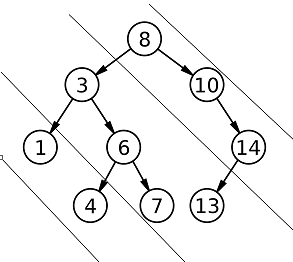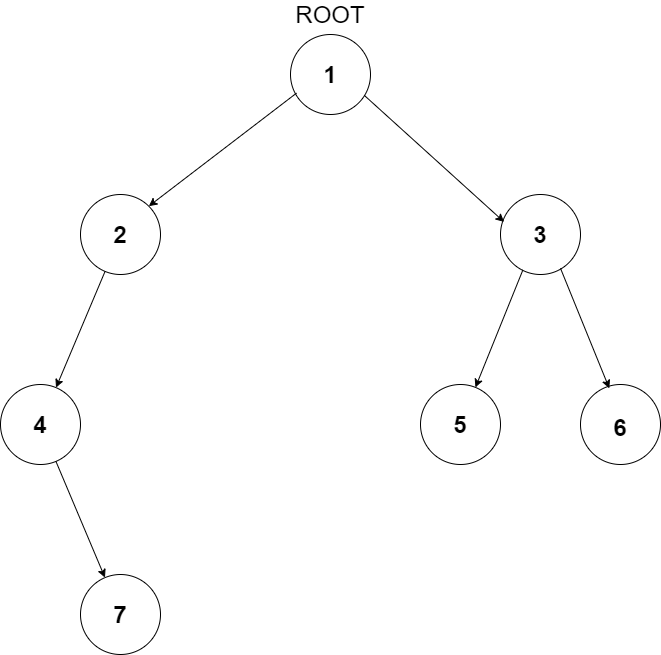Diagonal Sum
Given a Binary Tree of 'N' nodes, find and print a list containing the sums of all the diagonals. When calculating the sum of each diagonal, consider the diagonals from right to left.
Diagonals of the binary tree are :

There are three diagonals :
Diagonal 1 : 8 10 14
Diagonal 2 : 3 6 7 13
Diagonal 3 : 1 4
Example :
For the given binary tree :
Output : 24 14 2
Explanation: Rightmost diagonal contains elements {5, 10 , 9} its sum is 24, middle diagonal contains elements {6, 3, 5} its sum is 14, leftmost diagonal contains elements {2}. Thus the answer should be “24 14 2”.
Input Format :
The only line of the test case contains elements in the level order form. The line consists of values of nodes separated by a single space. In case a node is null, we take -1 on its place.
For example, the input for the tree depicted in the below image would be :

1
2 3
4 -1 5 6
-1 7 -1 -1 -1 -1
-1 -1
Explanation :
Level 1 :
The root node of the tree is 1
Level 2 :
Left child of 1 = 2
Right child of 1 = 3
Level 3 :
Left child of 2 = 4
Right child of 2 = null (-1)
Left child of 3 = 5
Right child of 3 = 6
Level 4 :
Left child of 4 = null (-1)
Right child of 4 = 7
Left child of 5 = null (-1)
Right child of 5 = null (-1)
Left child of 6 = null (-1)
Right child of 6 = null (-1)
Level 5 :
Left child of 7 = null (-1)
Right child of 7 = null (-1)
The first not-null node (of the previous level) is treated as the parent of the first two nodes of the current level. The second not-null node (of the previous level) is treated as the parent node for the next two nodes of the current level and so on.
The input ends when all nodes at the last level are null (-1).
Note :
The above format was just to provide clarity on how the input is formed for a given tree.
The sequence will be put together in a single line separated by a single space. Hence, for the above-depicted tree, the input will be given as:
1 2 3 4 -1 5 6 -1 7 -1 -1 -1 -1 -1 -1
Output Format :
Print the only line of output will contain a list containing diagonal sums from right diagonal to left diagonal.
Note :
You are not required to print the output explicitly, it has already been taken care of. Just implement the function.
Constraints :
0 <= N <= 10^5
0 <= node.data <= 10^9
Time Limit : 1 sec
CodingNinjas
author
2y
Recursive Approach
- To store diagonal sum for each diagonal separately, HashMap (say, ‘MAP’) is used with its key as diagonal number and value as the sum of nodes in that diagonal.
- Assign a distance 0 t...read more
CodingNinjas
author
2y
Level Order Traversal
- To store diagonal sum for each diagonal separately, HashMap (say, ‘MAP’) is used with its key as diagonal number and value as the sum of nodes in that diagonal.
- Assign a distance 0...read more
Help your peers!
Add answer anonymously...
Top TCS Software Developer interview questions & answers
Popular interview questions of Software Developer
Stay ahead in your career. Get AmbitionBox app

Helping over 1 Crore job seekers every month in choosing their right fit company
65 L+
Reviews
4 L+
Interviews
4 Cr+
Salaries
1 Cr+
Users/Month
Contribute to help millions
Get AmbitionBox app
